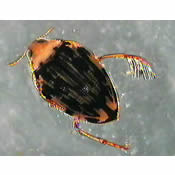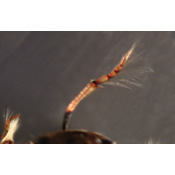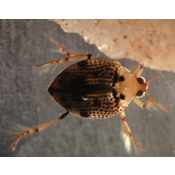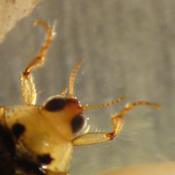| Distinguishing Characteristics | ||||||||||
|
||||||||||
| Additional Pictures | ||||||||||
|
||||||||||
| Ecology | ||||||||||
Haliplidae, or the Crawling Water beetle, gets its name from its poor swimming abilities. Rather than swim, the beetle clings to submerged vegetation and crawls along the bottom of the stream or pond that it inhabits. This slow movement supports the idea that they are herbivores in all life stages, although it has been thought that the adults were partially carnivorous. Haliplidae diet preferences are varied based on species. For example, diets can range from a mixture of chironomid eggs, oligochaet worms and small crustaceans, to hydrozoans, algae, characeans and seed-baring plants (3). The adults range in size from 2.5-4.5mm, and have beautiful spotted shells with uniform rows of black punctures. Their colors range from brown/orange, to yellow/green. Their backs are boat shaped, coming to a point at the rear, and are extremely convex. An easily identifiable feature of this beetle is its ventral view. All Crawling Water beetles possess the characteristic of a flattened sternal ridge, running from the prosternum down to the abdomen. And, they have the fairly uncommon feature of metacoxal plates that cover their basal segments, and the first 2 segments of their legs. The abdomen is comepletely shielded by these features. These plates assist adults in storeing oxygen obtained at the surface in three places; under the wings, at the tail, and under the large coxal plates. This allows the beetle to breathe underwater for extended periods of time (2). They also have protruding eyes and filiform antennae with 11 segments, and their basal antennae are unusually short. Unlike most water beetles, the haliplids are able to remain active through the winter. They congregate in deep water among aquatic plants and where air bubbles collect under the ice (1). The larvae of this beetle vary widely in appearance, with some species having many spine-tipped filaments radiating from the body, giving it the appearance of a small water porcupine. Other species have no filaments at all. All larvae have some form of forks or teeth on their legs or basal abdominal segment. |
||||||||||
| Videos | ||||||||||
|
||||||||||
| Additional Links | ||||||||||
| Bibliography | ||||||||||
|






